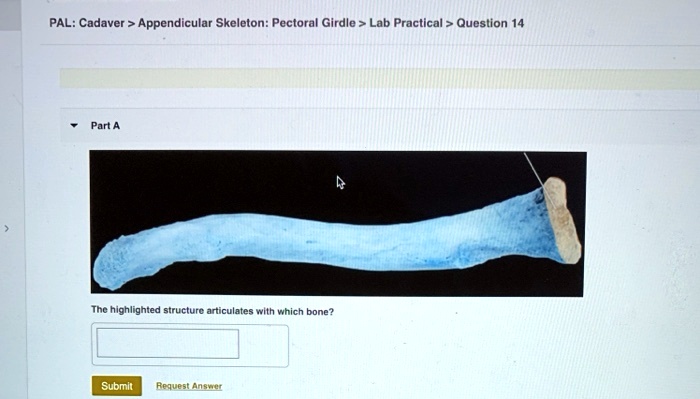Pal Cadaver Appendicular Skeleton Pectoral Girdle Lab Practical Question 1: a gateway to understanding the intricate workings of the human musculoskeletal system. This practical question invites us on an anatomical odyssey, where we delve into the appendicular skeleton and pectoral girdle, unraveling their significance in movement and function.
The appendicular skeleton, comprising the bones of the limbs, and the pectoral girdle, which connects the upper limbs to the axial skeleton, form a dynamic framework that enables a wide range of movements. This lab practical question provides a hands-on opportunity to examine these structures, fostering a deeper comprehension of their anatomy and biomechanics.
1. Pal Cadaver Appendicular Skeleton Pectoral Girdle Lab Practical Question 1

Purpose of the Lab Practical Question, Pal cadaver appendicular skeleton pectoral girdle lab practical question 1
The purpose of this lab practical question is to assess students’ knowledge of the appendicular skeleton and pectoral girdle. Students will be required to identify the bones of these structures, describe their articulations, and discuss their clinical significance.
Overview of the Appendicular Skeleton and Pectoral Girdle
The appendicular skeleton consists of the bones of the upper and lower limbs, as well as the pectoral girdle and pelvic girdle. The pectoral girdle connects the upper limbs to the axial skeleton and consists of the clavicle and scapula.
2. Identification of Bones

| Bone | Location | Function |
|---|---|---|
| Clavicle | Anterior chest | Connects the sternum to the scapula |
| Scapula | Posterior chest | Connects the clavicle to the humerus |
| Humerus | Upper arm | Forms the shoulder joint |
| Radius | Forearm | Forms the forearm with the ulna |
| Ulna | Forearm | Forms the forearm with the radius |
| Carpals | Wrist | Form the wrist joint |
| Metacarpals | Hand | Form the palm of the hand |
| Phalanges | Fingers | Form the fingers |
3. Articulations: Pal Cadaver Appendicular Skeleton Pectoral Girdle Lab Practical Question 1
Types of Articulations
The articulations of the pectoral girdle and appendicular skeleton include:
- Synovial joints:Freely movable joints that allow for a wide range of motion.
- Cartilaginous joints:Joints that are connected by cartilage and allow for limited movement.
- Fibrous joints:Immovable joints that are connected by fibrous tissue.
Examples and Functions
- Shoulder joint:A synovial joint between the humerus and scapula that allows for a wide range of motion, including flexion, extension, abduction, adduction, and rotation.
- Elbow joint:A synovial joint between the humerus, radius, and ulna that allows for flexion and extension of the forearm.
- Wrist joint:A synovial joint between the radius, ulna, and carpals that allows for flexion, extension, and radial and ulnar deviation.
4. Muscles
- Pectoralis major:Originates from the clavicle and sternum and inserts on the humerus. Flexes and adducts the arm.
- Deltoid:Originates from the clavicle, acromion, and spine of the scapula and inserts on the humerus. Abducts the arm.
- Biceps brachii:Originates from the scapula and inserts on the radius. Flexes the elbow joint.
- Triceps brachii:Originates from the humerus and inserts on the ulna. Extends the elbow joint.
- Brachioradialis:Originates from the humerus and inserts on the radius. Flexes the forearm at the elbow joint.
5. Movements
The pectoral girdle and appendicular skeleton allow for a wide range of movements, including:
- Flexion:Bending a joint
- Extension:Straightening a joint
- Abduction:Moving a limb away from the midline of the body
- Adduction:Moving a limb towards the midline of the body
- Rotation:Turning a limb around its axis
These movements are produced by the coordinated action of the muscles and articulations of the pectoral girdle and appendicular skeleton.
6. Clinical Significance

Injuries to the pectoral girdle and appendicular skeleton can affect movement and function. Common injuries include:
- Clavicle fractures:Can occur due to falls or direct blows to the shoulder.
- Scapula fractures:Can occur due to falls or direct blows to the back.
- Humerus fractures:Can occur due to falls or direct blows to the arm.
- Dislocations:Can occur when a joint is forced out of its normal position.
- Tendon injuries:Can occur due to overuse or trauma.
These injuries can be treated with a variety of methods, including surgery, physical therapy, and medication.
FAQ Explained
What is the purpose of the pectoral girdle?
The pectoral girdle, consisting of the clavicles and scapulae, provides structural support for the upper limbs and facilitates their articulation with the axial skeleton.
Name the bones that make up the appendicular skeleton.
The appendicular skeleton includes the bones of the upper and lower limbs, such as the humerus, radius, ulna, femur, tibia, and fibula.
What types of articulations are found in the pectoral girdle and appendicular skeleton?
The pectoral girdle and appendicular skeleton exhibit various types of articulations, including synovial, cartilaginous, and fibrous joints, each with distinct characteristics and functions.